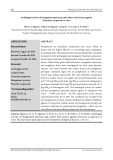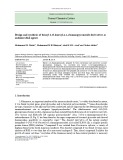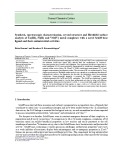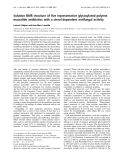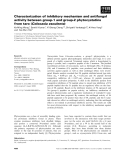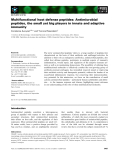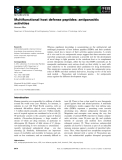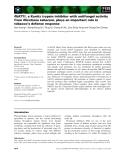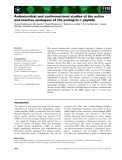
Antifungal activity
-
Polyphenols are secondary compounds that occur widely in plants and are highly effective in controlling plant pathogenic microorganisms. This study aimed to screen polyphenolic-rich plant extracts for their antifungal potential against Fusarium oxysporum.
 12p
12p  tuetuebinhan000
tuetuebinhan000
 23-01-2025
23-01-2025
 3
3
 2
2
 Download
Download
-
The structure activity relationship (SAR) study revealed that incorporation of 4-O-lauroyl group in rhamnopyranoside frame work along with 2,3-di-O-acyl group increased the antifungal potentiality of the rhamnopyranosides.
 10p
10p  tocectocec
tocectocec
 25-05-2020
25-05-2020
 10
10
 2
2
 Download
Download
-
A new series of transition metal complexes of Co(III), Ni(II) and VO(IV) was synthesized with the bidentate Schiff base ligand (HL) derived from the condensation of 2-amino-3-benzyloxypyridine and 5-bromo salicylaldehyde.
 14p
14p  tocectocec
tocectocec
 25-05-2020
25-05-2020
 26
26
 2
2
 Download
Download
-
Glycosylatedpolyenemacrolide antibiotics, as nystatins and amphotericins, are amphiphilic structures known to exert antifungal activity by disrupting the fungal cell membrane, leading to leakage of cellular materials, and cell death. This membrane disruption is strongly influenced by the presence and the exact nature of the membrane sterols.
 9p
9p  research12
research12
 23-04-2013
23-04-2013
 39
39
 2
2
 Download
Download
-
Tarocystatin from Colocasia esculenta, a group-2 phytocystatin, is a defense protein against phytopathogenic nematodes and fungi. It is com-posed of a highly conserved N-terminal region, which is homological to group-1 cystatin, and a repetitive peptide at the C-terminus.
 10p
10p  vinaphone15
vinaphone15
 28-02-2013
28-02-2013
 41
41
 2
2
 Download
Download
-
The term ‘antimicrobial peptides’ refers to a large number of peptides first characterized on the basis of their antibiotic and antifungal activities. In addition to their role as endogenous antibiotics, antimicrobial peptides, also called host defense peptides, participate in multiple aspects of immunity (inflammation, wound repair, and regulation of the adaptive immune sys-tem) as well as in maintaining homeostasis.
 12p
12p  viettel02
viettel02
 20-02-2013
20-02-2013
 49
49
 3
3
 Download
Download
-
Whereas significant knowledge is accumulating on the antibacterial and antifungal properties of host defense peptides (HDPs) and their synthetic mimics, much less is known of their activities against parasites. A variety ofin vitro andin vivo antiparasitic assays suggest that these notorious anti-microbial compounds could represent a powerful tool for the development of novel drugs to fight parasites in the vertebrate host or to complement current therapeutic strategies
 9p
9p  viettel02
viettel02
 20-02-2013
20-02-2013
 43
43
 3
3
 Download
Download
-
A cDNA library from tobacco inoculated withRhizoctonia solaniwas con-structed, and several cDNA fragments were identified by differential hybridization screening. One cDNA clone that was dramatically repressed, NtKTI1, was confirmed as a member of the Kunitz plant proteinase inhibi-tor family. RT-PCR analysis revealed that NtKTI1was constitutively expressed throughout the whole plant and preferentially expressed in the roots and stems.
 13p
13p  viettel02
viettel02
 19-02-2013
19-02-2013
 38
38
 4
4
 Download
Download
-
The natural antimicrobial cationic peptide protegrin-1 displays a broad spectrum of antimicrobial activity and rapidly kills pathogens by interacting with their cell membrane. We investigated the structure–activity relation-ships of three protegrin-1 analogues: IB-367 (RGGLCYCRGRFCVCVGR-NH2), BM-1 (RGLCYCRGRFCVCVG-NH2) and BM-2 (RGLCYRPRFV CVG-NH2). Our antimicrobial and antifungal activity studies of these peptides showed that BM-1 was much more active than IB-367 against Gram-positive bacteria and fungi, whereas BM-2 was inactive. ...
 13p
13p  mobifone23
mobifone23
 18-01-2013
18-01-2013
 55
55
 4
4
 Download
Download
CHỦ ĐỀ BẠN MUỐN TÌM








